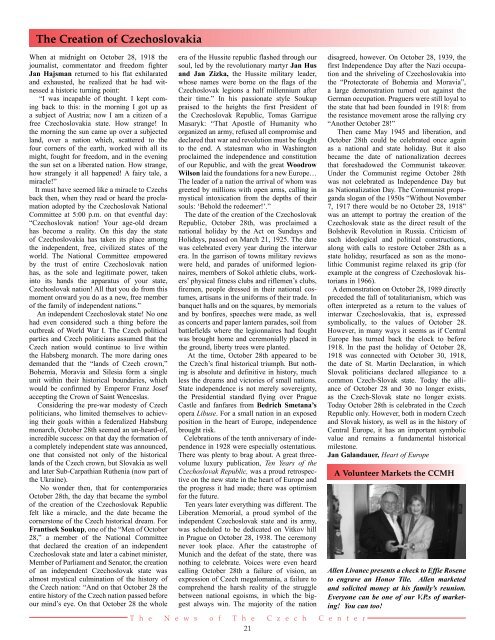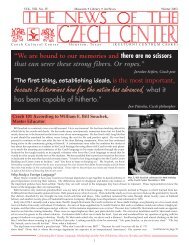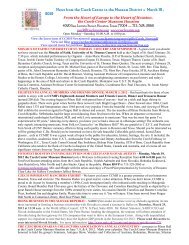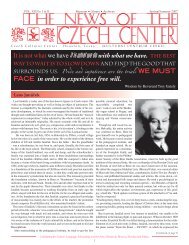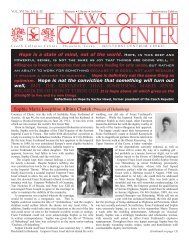If you lived as I did, several years under Nazi totalitarianism, and ...
If you lived as I did, several years under Nazi totalitarianism, and ...
If you lived as I did, several years under Nazi totalitarianism, and ...
You also want an ePaper? Increase the reach of your titles
YUMPU automatically turns print PDFs into web optimized ePapers that Google loves.
The Creation of Czechoslovakia<br />
When at midnight on October 28, 1918 the<br />
journalist, commentator <strong>and</strong> freedom fighter<br />
Jan Hajsman returned to his flat exhilarated<br />
<strong>and</strong> exhausted, he realized that he had witnessed<br />
a historic turning point:<br />
“I w<strong>as</strong> incapable of thought. I kept coming<br />
back to this: in the morning I got up <strong>as</strong><br />
a subject of Austria; now I am a citizen of a<br />
free Czechoslovakia state. How strange! In<br />
the morning the sun came up over a subjected<br />
l<strong>and</strong>, over a nation which, scattered to the<br />
four corners of the earth, worked with all its<br />
might, fought for freedom, <strong>and</strong> in the evening<br />
the sun set on a liberated nation. How strange,<br />
how strangely it all happened! A fairy tale, a<br />
miracle!”<br />
It must have seemed like a miracle to Czechs<br />
back then, when they read or heard the proclamation<br />
adopted by the Czechoslovak National<br />
Committee at 5:00 p.m. on that eventful day:<br />
“Czechoslovak nation! Your age-old dream<br />
h<strong>as</strong> become a reality. On this day the state<br />
of Czechoslovakia h<strong>as</strong> taken its place among<br />
the independent, free, civilized states of the<br />
world. The National Committee empowered<br />
by the trust of entire Czechoslovak nation<br />
h<strong>as</strong>, <strong>as</strong> the sole <strong>and</strong> legitimate power, taken<br />
into its h<strong>and</strong>s the apparatus of <strong>you</strong>r state,<br />
Czechoslovak nation! All that <strong>you</strong> do from this<br />
moment onward <strong>you</strong> do <strong>as</strong> a new, free member<br />
of the family of independent nations.”<br />
An independent Czechoslovak state! No one<br />
had even considered such a thing before the<br />
outbreak of World War I. The Czech political<br />
parties <strong>and</strong> Czech politicians <strong>as</strong>sumed that the<br />
Czech nation would continue to live within<br />
the Habsberg monarch. The more daring ones<br />
dem<strong>and</strong>ed that the “l<strong>and</strong>s of Czech crown,”<br />
Bohemia, Moravia <strong>and</strong> Silesia form a single<br />
unit within their historical boundaries, which<br />
would be confirmed by Emperor Franz Josef<br />
accepting the Crown of Saint Wencesl<strong>as</strong>.<br />
Considering the pre-war modesty of Czech<br />
politicians, who limited themselves to achieving<br />
their goals within a federalized Habsburg<br />
monarch, October 28th seemed an un-heard-of,<br />
incredible success: on that day the formation of<br />
a completely independent state w<strong>as</strong> announced,<br />
one that consisted not only of the historical<br />
l<strong>and</strong>s of the Czech crown, but Slovakia <strong>as</strong> well<br />
<strong>and</strong> later Sub-Carpathian Ruthenia (now part of<br />
the Ukraine).<br />
No wonder then, that for contemporaries<br />
October 28th, the day that became the symbol<br />
of the creation of the Czechoslovak Republic<br />
felt like a miracle, <strong>and</strong> the date became the<br />
cornerstone of the Czech historical dream. For<br />
Frantisek Soukup, one of the “Men of October<br />
28,” a member of the National Committee<br />
that declared the creation of an independent<br />
Czechoslovak state <strong>and</strong> later a cabinet minister,<br />
Member of Parliament <strong>and</strong> Senator, the creation<br />
of an independent Czechoslovak state w<strong>as</strong><br />
almost mystical culmination of the history of<br />
the Czech nation: “And on that October 28 the<br />
entire history of the Czech nation p<strong>as</strong>sed before<br />
our mind’s eye. On that October 28 the whole<br />
era of the Hussite republic fl<strong>as</strong>hed through our<br />
soul, led by the revolutionary martyr Jan Hus<br />
<strong>and</strong> Jan Zizka, the Hussite military leader,<br />
whose names were borne on the flags of the<br />
Czechoslovak legions a half millennium after<br />
their time.” In his p<strong>as</strong>sionate style Soukup<br />
praised to the heights the first President of<br />
the Czechoslovak Republic, Tom<strong>as</strong> Garrigue<br />
M<strong>as</strong>aryk: “That Apostle of Humanity who<br />
organized an army, refused all compromise <strong>and</strong><br />
declared that war <strong>and</strong> revolution must be fought<br />
to the end. A statesman who in W<strong>as</strong>hington<br />
proclaimed the independence <strong>and</strong> constitution<br />
of our Republic, <strong>and</strong> with the great Woodrow<br />
Wilson laid the foundations for a new Europe…<br />
The leader of a nation the arrival of whom w<strong>as</strong><br />
greeted by millions with open arms, calling in<br />
mystical intoxication from the depths of their<br />
souls: ‘Behold the redeemer!’.”<br />
The date of the creation of the Czechoslovak<br />
Republic, October 28th, w<strong>as</strong> proclaimed a<br />
national holiday by the Act on Sundays <strong>and</strong><br />
Holidays, p<strong>as</strong>sed on March 21, 1925. The date<br />
w<strong>as</strong> celebrated every year during the interwar<br />
era. In the garrison of towns military reviews<br />
were held, <strong>and</strong> parades of uniformed legionnaires,<br />
members of Sokol athletic clubs, workers’<br />
physical fitness clubs <strong>and</strong> riflemen’s clubs,<br />
firemen, people dressed in their national costumes,<br />
artisans in the uniforms of their trade. In<br />
banquet halls <strong>and</strong> on the squares, by memorials<br />
<strong>and</strong> by bonfires, speeches were made, <strong>as</strong> well<br />
<strong>as</strong> concerts <strong>and</strong> paper lantern parades, soil from<br />
battlefields where the legionnaires had fought<br />
w<strong>as</strong> brought home <strong>and</strong> ceremonially placed in<br />
the ground, liberty trees were planted.<br />
At the time, October 28th appeared to be<br />
the Czech’s final historical triumph. But nothing<br />
is absolute <strong>and</strong> definitive in history, much<br />
less the dreams <strong>and</strong> victories of small nations.<br />
State independence is not merely sovereignty,<br />
the Presidential st<strong>and</strong>ard flying over Prague<br />
C<strong>as</strong>tle <strong>and</strong> fanfares from Bedrich Smetana’s<br />
opera Libuse. For a small nation in an exposed<br />
position in the heart of Europe, independence<br />
brought risk.<br />
Celebrations of the tenth anniversary of independence<br />
in 1928 were especially ostentatious.<br />
There w<strong>as</strong> plenty to brag about. A great threevolume<br />
luxury publication, Ten Years of the<br />
Czechoslovak Republic, w<strong>as</strong> a proud retrospective<br />
on the new state in the heart of Europe <strong>and</strong><br />
the progress it had made; there w<strong>as</strong> optimism<br />
for the future.<br />
Ten <strong>years</strong> later everything w<strong>as</strong> different. The<br />
Liberation Memorial, a proud symbol of the<br />
independent Czechoslovak state <strong>and</strong> its army,<br />
w<strong>as</strong> scheduled to be dedicated on Vitkov hill<br />
in Prague on October 28, 1938. The ceremony<br />
never took place. After the cat<strong>as</strong>trophe of<br />
Munich <strong>and</strong> the defeat of the state, there w<strong>as</strong><br />
nothing to celebrate. Voices were even heard<br />
calling October 28th a failure of vision, an<br />
expression of Czech megalomania, a failure to<br />
comprehend the harsh reality of the struggle<br />
between national egoisms, in which the biggest<br />
always win. The majority of the nation<br />
T h e N e w s o f T h e C z e c h C e n t e r<br />
21<br />
disagreed, however. On October 28, 1939, the<br />
first Independence Day after the <strong>Nazi</strong> occupation<br />
<strong>and</strong> the shriveling of Czechoslovakia into<br />
the “Protectorate of Bohemia <strong>and</strong> Moravia”,<br />
a large demonstration turned out against the<br />
German occupation. Praguers were still loyal to<br />
the state that had been founded in 1918: from<br />
the resistance movement arose the rallying cry<br />
“Another October 28!”<br />
Then came May 1945 <strong>and</strong> liberation, <strong>and</strong><br />
October 28th could be celebrated once again<br />
<strong>as</strong> a national <strong>and</strong> state holiday. But it also<br />
became the date of nationalization decrees<br />
that foreshadowed the Communist takeover.<br />
Under the Communist regime October 28th<br />
w<strong>as</strong> not celebrated <strong>as</strong> Independence Day but<br />
<strong>as</strong> Nationalization Day. The Communist propag<strong>and</strong>a<br />
slogan of the 1950s “Without November<br />
7, 1917 there would be no October 28, 1918”<br />
w<strong>as</strong> an attempt to portray the creation of the<br />
Czechoslovak state <strong>as</strong> the direct result of the<br />
Bolshevik Revolution in Russia. Criticism of<br />
such ideological <strong>and</strong> political constructions,<br />
along with calls to restore October 28th <strong>as</strong> a<br />
state holiday, resurfaced <strong>as</strong> son <strong>as</strong> the monolithic<br />
Communist regime relaxed its grip (for<br />
example at the congress of Czechoslovak historians<br />
in 1966).<br />
A demonstration on October 28, 1989 directly<br />
preceded the fall of <strong>totalitarianism</strong>, which w<strong>as</strong><br />
often interpreted <strong>as</strong> a return to the values of<br />
interwar Czechoslovakia, that is, expressed<br />
symbolically, to the values of October 28.<br />
However, in many ways it seems <strong>as</strong> if Central<br />
Europe h<strong>as</strong> turned back the clock to before<br />
1918. In the p<strong>as</strong>t the holiday of October 28,<br />
1918 w<strong>as</strong> connected with October 30, 1918,<br />
the date of St. Martin Declaration, in which<br />
Slovak politicians declared allegiance to a<br />
common Czech-Slovak state. Today the alliance<br />
of October 28 <strong>and</strong> 30 no longer exists,<br />
<strong>as</strong> the Czech-Slovak state no longer exists.<br />
Today October 28th is celebrated in the Czech<br />
Republic only. However, both in modern Czech<br />
<strong>and</strong> Slovak history, <strong>as</strong> well <strong>as</strong> in the history of<br />
Central Europe, it h<strong>as</strong> an important symbolic<br />
value <strong>and</strong> remains a fundamental historical<br />
milestone.<br />
Jan Gal<strong>and</strong>auer, Heart of Europe<br />
A Volunteer Markets the CCMH<br />
Allen Livanec presents a check to Effie Rosene<br />
to engrave an Honor Tile. Allen marketed<br />
<strong>and</strong> solicited money at his family’s reunion.<br />
Everyone can be one of our V.P.s of marketing!<br />
You can too!


